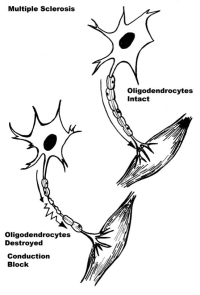Multiple Sclerosis (MS) Overview
In a normal immune response, alien proteins such as those of bacterial or viral origin trigger the immune system to destroy the invading organism. In an autoimmune disorder, the immune system becomes confused and develop sensitivity to normal body proteins. When the immune response mistakenly identifies these normal host proteins as “foreign invaders”, inflammation, swelling and nerve destruction can occur. This is the basis of an autoimmune disorder.
Multiple Sclerosis (MS) is an autoimmune disease that involves antibodies attacking the myelin sheath of the central nervous system. Myelin is the wrapping of the nerve cell with an insulator type cell.
These insulator type cells are made of specialized cells called oligodendrocytes (found in the central nervous system) that wrap themselves around the axon (the nerve cell body) like a burrito. There are gaps between these insulator cells. The action potential (the nerve signal) jumps from gap to gap between these cells, significantly increasing the speed of conduction (how fast the signal conducts down the “wire”). If a disease processes like multiple sclerosis destroys these specialized insulation cells, the nerve signal slows or is completely blocked.
Are you suffering from symptoms of Multiple Sclerosis (MS)?
Would you like to consult with Dr. Corenman about your condition?
You can set up a long distance consultation to discuss your
current X-rays and/or MRIs for a clinical case review.
(Please keep reading below for more information on this condition.)
The term “Multiple Sclerosis” really is a good descriptor of this disorder. There are multiple patches of sclerosis (hardening type scar) that occur in the nervous system which includes the brain and spinal cord. These sclerotic patches can block nerve signals or cause the nerve cells to trigger producing false sensations. The is like a door bell with a short in the wire-ringing when no one is at the door.
With Multiple Sclerosis, females normally outnumber males 2:1. The onset of multiple sclerosis is typically between the ages of 20-40. The symptoms start in a variety of locations. Vision loss in one eye, double vision, unusual paresthesias in the arms or legs, or incoordination all can be associated with multiple sclerosis.
Fatigue, imbalance, and dizziness also are related. The symptoms can be mild or progressive. This disorder is found more often in light-skinned individuals from the northern European descent but can affect anyone. The physical examination typically will demonstrate upper motor neuron findings (hyperreflexia, Hoffman’s sign, clonus, Babinski’s and incoordination).
Diagnosis is important as some treatments can slow or alter the progress of this disease. MRI is used to diagnose the disease in the brain or spinal cord, and a laboratory analysis of cerebral spinal fluid can assist with diagnosis.
To discuss Multiple Sclerosis (MS) in more detail, please contact the Vail, Aspen, Denver and Grand Junction, Colorado area office of back doctor and spine specialist Dr. Donald Corenman.

